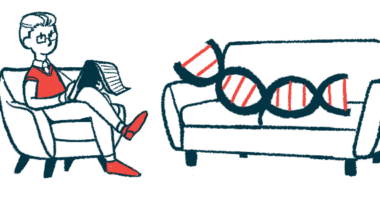Gal A Activity Nears Normal in 2nd Man Given FLT190 Gene Therapy

FLT190, Freeline Therapeutics’ experimental gene therapy, led to sustained increases in alpha-galactosidase A (Gal A), the faulty enzyme in Fabry disease, in the first two patients given the one-time therapy in the Phase 1/2 MARVEL-1 clinical trial.
Notably, the second patient, dosed early this year, has reached near-normal Gal A levels and remained free of enzyme replacement therapy (ERT) four months post-treatment.
These “highly encouraging” results were achieved in the trial’s low-dose group “and already FLT190 appears to be having a significant impact on [Gal A] activity and disease process in Fabry, which is the underlying goal and promise of the FLT190 program,” Michael Parini, Freeline’s CEO, said in a press release.
While the therapy has been generally well-tolerated to date, both patients experienced temporary, mild inflammation of the heart muscle, a condition known as myocarditis. This potential safety concern will be further evaluated in a third patient before considering advancing the trial to a planned higher dose group.
“This step is consistent with the recommendation of our independent Data Monitoring Committee, with whom we have worked to review the data,” Parini said.
Given that myocarditis was not reported in the 10 patients given FLT180a, Freeline’s investigational gene therapy for hemophilia B, in a previous trial, “it’s likely that Fabry patients are predisposed to developing this by virtue of the pre-existing cardiomyopathy [heart disease] they often have,” said Atul B. Mehta, MD, formerly clinical director of the lysosomal storage disorders unit at the Royal Free London NHS Foundation Trust.
“Appropriate measures for even closer observation and monitoring have been introduced to ensure the safety of future trial participants,” Mehta added.
Freeline is now working with regulatory authorities to strengthen data monitoring for FLT190, and patient dosing is expected to continue in the first months of 2022 following these updates. Additional trial safety and efficacy data are anticipated next year.
Administered directly into the bloodstream, FLT190 uses a modified and harmless liver-directed adeno-associated virus to deliver to cells a healthy version of the GLA gene, which provides the instructions to produce Gal A and is mutated in Fabry patients.
By providing a working GLA copy, the one-time therapy is expected to restore Gal A levels, and thereby prevent the disease-characteristic toxic accumulation of fatty molecules — Gb3 and Lyso-Gb3 — that can damage the heart, kidneys, and liver.
With this treatment, patients are expected to no longer need regular, standard ERT or chaperone therapy. ERT delivers a lab-made version of Gal A to patients, while chaperone therapy is able to restore the function of some faulty forms of Gal.
The dose-finding Phase 1/2 MARVEL-1 trial (NCT04040049) is evaluating FLT190’s safety and effectiveness in up to 15 men with classic Fabry disease, which is associated with total or near-total absence of working Gal A. The trial is taking place at five sites across Europe; more information can be found here.
In the study’s dose-escalation first phase, patients who were previously treated with ERT or chaperone therapy will receive ascending doses of FLT190 to determine the safest and most effective dose. Four doses are planned for evaluation: 7.5×1011, 1.5×1012, 4.5×1012, and 1.5×1013 vector genomes (vg) per kg of body weight.
FLT190’s optimal dose will then be tested in the trial’s second phase involving patients who have not received prior treatment.
After nine months of post-dosing follow-up, participants may choose to enter a long-term extension study.
The trial’s main goal is to assess the therapy’s safety, while secondary goals include changes in Gal A activity, and in Gb3 and Lyso-Gb3 levels. Changes in kidney and heart function and quality of life will also be assessed, as well as the ability of the carrier virus to drive immune responses.
Newly shared results concerned the first two men treated with the lowest dose (7.5×1011 vg/kg), with a data cut-off date of Oct. 6.
In the first patient, treated in September 2019, FLT190 led to a sustained, three-fold increase in Gal A activity levels, which have generally remained steady over two years. Still, the man showed blood Gal A levels of 0.8-1.3 nanomole per hour per milliliter (nmol/hour/mL) — representing a sub-therapeutic response — and restarted an ERT one and a half month later.
A sustainable and durable increase in Gal A levels was also observed in the second patient, who received the therapy’s single dose in June. Enzyme activity levels raised from zero at study start to a mean of 3.9 nmol/hour/mL — closer to the normal range of 6–19 nmol/hr/mL — between 1.5 months and four months post-dosing. The patient remains off ERT.
Compared with the first patient, the second patient saw a 400% greater increase in Gal A levels, likely due to the fact that he received a 40% higher total viral load due to weight differences.
To date, the therapy has been generally safe and well-tolerated, with no reports of dose-limiting toxicities or serious adverse events.
However, both men experienced an episode of temporary, mild myocarditis in the first months after treatment. Their heart functioning has remained normal throughout the study.
In the second patient, who has a history of heart disease, the event was detected on routine weekly monitoring as he had no symptoms. No clinical sequelae or evidence of heart tissue scarring has been detected in the first patient up to two years post-dosing.
In addition, the company’s “proactive immune management regimen, which is being deployed across all of our [gene therapy] programs, has been effective as no elevations of liver enzymes have been observed throughout the treatment period,” Parini said.
Increases in liver enzymes, indicative of liver damage, are a common adverse event of virus-based gene therapies.
FLT190 has been designated an orphan drug in both the U.S. and Europe for the treatment of Fabry disease. This designation is meant to accelerate the therapy’s development and review by providing regulatory support and financial incentives, most notably a market exclusivity period (of seven years in the U.S. and 10 years in Europe) if the medication is approved.






